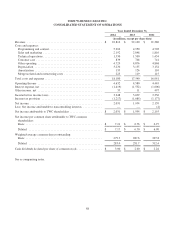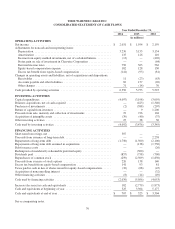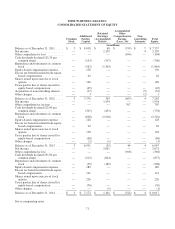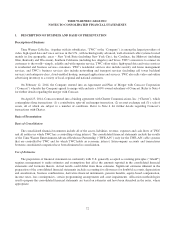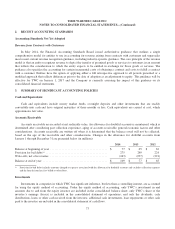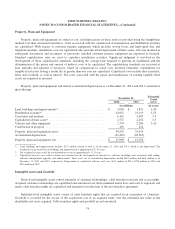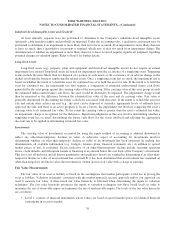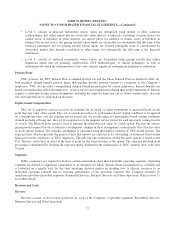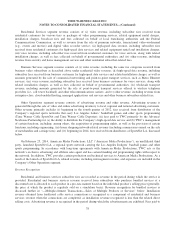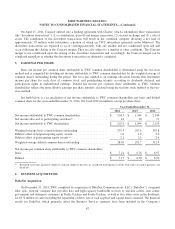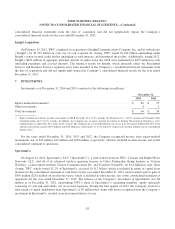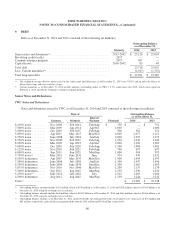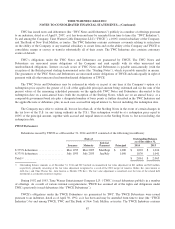Time Warner Cable 2014 Annual Report Download - page 85
Download and view the complete annual report
Please find page 85 of the 2014 Time Warner Cable annual report below. You can navigate through the pages in the report by either clicking on the pages listed below, or by using the keyword search tool below to find specific information within the annual report.TIME WARNER CABLE INC.
NOTES TO CONSOLIDATED FINANCIAL STATEMENTS—(Continued)
• Level 2: consists of financial instruments whose values are determined using models or other valuation
methodologies that utilize inputs that are observable either directly or indirectly, including (i) quoted prices for
similar assets or liabilities in active markets, (ii) quoted prices for identical or similar assets or liabilities in
markets that are not active, (iii) pricing models whose inputs are observable for substantially the full term of the
financial instrument and (iv) pricing models whose inputs are derived principally from or corroborated by
observable market data through correlation or other means for substantially the full term of the financial
instrument.
• Level 3: consists of financial instruments whose values are determined using pricing models that utilize
significant inputs that are primarily unobservable, DCF methodologies, or similar techniques, as well as
instruments for which the determination of fair value requires significant management judgment or estimation.
Pension Plans
TWC sponsors the TWC Pension Plan (as defined in Note 14) and the Union Pension Plan (as defined in Note 14),
both qualified defined benefit pension plans, that together provide pension benefits to a majority of the Company’s
employees. TWC also provides a nonqualified defined benefit pension plan for certain employees. Pension benefits are
based on formulas that reflect the employees’ years of service and compensation during their employment period. Pension
expense is determined using certain assumptions, including the expected long-term rate of return on plan assets, discount
rate and expected rate of compensation increases.
Equity-based Compensation
The cost of employee services received in exchange for an award of equity instruments is measured based on the
grant date fair value of the award. The cost of awards not subject to performance-based vesting conditions is recognized
on a straight-line basis over the requisite service period and, for awards subject to performance-based vesting conditions
deemed probable of being met, the cost is recognized over the requisite service period for each separately vesting tranche
of awards. The Black-Scholes model is used to estimate the grant date fair value of a stock option. Because the option-
pricing model requires the use of subjective assumptions, changes in these assumptions can materially affect the fair value
of stock options granted. The volatility assumption is calculated using the implied volatility of TWC traded options. The
expected term, which represents the period of time that options are expected to be outstanding, is estimated based on the
historical exercise experience of TWC employees. The risk-free rate assumed in valuing the stock options is based on the
U.S. Treasury yield curve in effect at the time of grant for the expected term of the option. The expected dividend yield
percentage is determined by dividing the expected annual dividend by the market price of TWC common stock at the date
of grant.
Segments
Public companies are required to disclose certain information about their reportable operating segments. Operating
segments are defined as significant components of an enterprise for which separate financial information is available and
is evaluated on a regular basis by the chief operating decision makers in deciding how to allocate resources to an
individual operating segment and in assessing performance of the operating segment. The Company classifies its
operations into three reportable segments: Residential Services, Business Services and Other Operations. Refer to Note 17
for further details.
Revenue and Costs
Revenue
Revenue consists of the revenue generated by each of the Company’s reportable segments: Residential Services,
Business Services and Other Operations.
77



